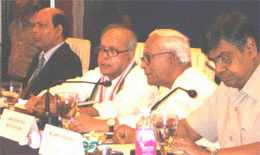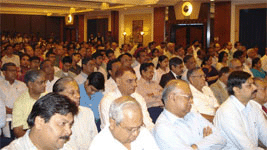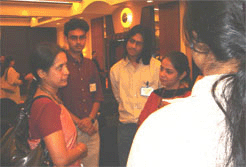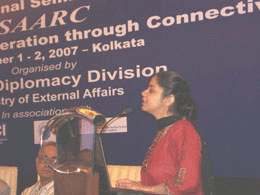 |
|
|
The National Seminar on SAARC: Accelerating Cooperation through Connectivity A Report By Ms. Sayantani Sen Mazumdar and Mr. Anurag Sinha The national seminar on SAARC: Accelerating Cooperation through Connectivity was organized by the Ministry of External Affairs (MEA), in collaboration with the Global India Foundation (GIF), the Federation of Indian Chambers of Commerce and Industries (FICCI), and Research and Information Systems (RIS) on September 1-2, 2007 at the Park Hotel, Kolkata. Any academic endeavour, aimed at impacting policy-change and development, succeeds only when backed by an adequate response from the policy-making circles. The seminar was one such example, where policy-makers came together with noted academics and professionals to envisage the future directions of the SAARC. Day I, Session I The pièce de résistance on the opening day was provided by the participation of External Affairs Minister Shri Pranab Mukherjee and the Chief Minister of West Bengal, Shri Buddhadeb Bhattacharjee, following the opening remarks of Prof. Omprakash Mishra, the Member Secretary of the GIF. Prof. Mishra elaborated on the conceptual linkages between Northeast India and the Look-East policy, and how the SAARC held the potential to facilitate these linkages. These linkages, along with the promise of greater economic integration, would pave the way for SAARC's arrival as a commendable regional organization. Both, Mr. Arif Khan (Add. Sec., PD, MEA) and Prof. Arjun Sengupta (MP, and Chairman, RIS) espoused the importance of the convergence of academic and policy-making circles (as mentioned above). The challenges to the SAARC and the acute problems facing its member nations have to be cogently understood to take advantage of the existing framework. That the SAARC is now more open to extra-regional participation (with the likes of Afghanistan, China, Japan, the EU, etc.) exemplifies the commitment to success which is brought by its supporters. If the SAARC has to go along the lines of an EU-inspired model, India would have to make ready sacrifices, in its capacity as the greatest power in the region. SAARC's success, Prof. Sengupta maintained, was dependent on a sense of oneness, which could only emerge from a clamour of opinions - whether political, commercial, or from the civil society. Shri Buddhadeb Bhattacharjee argued that the emphasis in SAARC members' interactions should lie in confidence-building measures. He called for a singular mechanism of cooperation, based on the ideals of economic alliance, industrial development and poverty alleviation. He blamed the WTO (and other such global institutions) to be rampantly partisan, inevitably to the detriment of developing nations. Regional cooperation is the only real effective counter to this trend, and SAARC posits a way forward for South Asia's development. The ratification of the SAFTA and the PTT in all member countries is essential to this process. Shri Bhattacharjee also identified terrorism as the greatest threat to South Asia's prosperity, and noted the power of knowledge in an age of information. He concluded by calling for a rejuvenation of tourism industries, greater communication links between member countries and a commitment to technological advancement.
Right: An overview of the gathering on 1st September 2007. Shri Pranab Mukherjee also spoke of the importance of identifying challenges and breaking them down through deliberation. Protectionism as a buffer in regional cooperation is neither feasible nor legitimate. Since India shares her borders with all the SAARC countries, she must take care not to follow protectionist policies. Mr. Mukherjee maintained that India has always readily sought to answer the challenges posed by hunger, poverty and inequality. Moreover, stressing on the issue at hand, he emphasized the salience of connectivity in the SAARC's development. Physical connectivity would enhance the mobility of labour, goods and services, and would more rapidly open up central and southeast Asia to the SAARC countries. For him, the gravest challenges were three-fold: terrorism, narcotics, and other transnational crimes. Calling for a zero-tolerance perspective on terrorism, he suggested that regional cooperation was the only viable alternative (as against the WTO) to answer the processes of globalization. Common prosperity is indivisible and interdependent and growth without development should not be the goal of developing countries. He concluded by elaborating on the many initiatives the SAARC has fostered - liberalized visa regimes, cultural programmes, student exchanges, a proposed SAARC University in New Delhi, and greater road, railway, and waterway connectivity to facilitate communication. Sudhir Jalan (Past President, FICCI), concluded the first morning's activities in saying that in the 'global village' of the world, cooperation is the name of the game. In raising a larger question, he said that if India can cooperate with countries like Brazil and South Africa, there remained no reason for not doing so with members of the SAARC. The South Asian nations need to draw closer together for mutual benefits. Open connectivity through open skies, open seaways, open roadways, and even open hearts, would pave the way for freedom to travel, freedom of movement, and the freedom to invest. Session II Dr. Pulin B. Nayak (Director, Delhi School of Economics) started with a worrying dichotomy evinced by the Indian economy - on one hand, high rates of GDP growth, low inflation, a high savings rate and tax-GDP ratio offer positive indications, while on the other, India still suffers from poverty, unemployment and a low level of social security. In order to address these problems we must understand that many SAARC countries face the same fate; therein, regional cooperation is the most desirable option to counter these pulls. Jagdish Bhagwati, Dr. Nayak said, has argued for multilateralism, as against regional cooperation, but, given the stalling of the WTO in many issues and the proliferation of regional cooperation the latter seemed to have an important role to play. On the contrary, Baldwin is of the opinion that regionalism does not necessarily contradict multilateralism and the ills of food insecurity, disease, under nutrition and illiteracy could be best addressed by a body like the SAARC. India is a major educational reservoir and, with the cooperation of other SAARC countries, it can play a vital role in disaster management and eliminating the existing challenges. He stated that regional liberalization is not inimical to multilateral liberalization. In conclusion, he claimed that we are at a historical juncture when India should think of opening up and reaching out to the immediate neighborhood.
Prof. Sushil Khanna (IIM, Calcutta), however, offered a word of caution amidst the tide of optimism. He argued that South Asia remains the least integrated region in the world, and this fragmentation has mostly been facilitated by India alone. Independent India’s economic endeavors proceeded with the inward-looking policies in 1950s and even cut off economic access to her poorest neighbours. In the 1990s, at the heights of globalization and liberalization, India opened up to the world but not its immediate neighbours. As a result, there prevails a large amount of illegal trade between the South Asian countries, with India as the most obvious channel. India’s stand towards its neighbors, though, underwent a positive change when Prime Minister I. K. Gujral started adopting favorable policies towards them. However, Prof. Khanna attributes this 'change of heart' to China’s rapid emergence in South Asia as a trading giant; the specter of China's dominance was the real urgency behind India's concessional regimes towards her neighbours. Prof. Ajitava Roy Choudhury (Jadavpur University) spoke of his concept of a political capital in South Asian countries. He regretted that the trade complementarities between SAARC countries are very low. Emphasizing on the concept of the value–chain, he conceded that planning for the same often becomes problematic. Planning for the service sector and better trade facilitation (thus mitigating illegal trade practices) are essential in South Asia. He concluded by arguing that the EU and SAARC as similes do not function. Diversification indices in the states of EU are much higher than that of the SAARC. The comparison would only be operational if the poorer East European countries were accommodated within the EU. Day II, Session I M. Jamshed (Director, Min. of Railways) commenced the deliberations by highlighting the potential of SAARC in paving the way for greater physical connectivity in South Asia, with India as the major hub. The potential for aviation and maritime gateways remain, along with the prospect of inland waterway corridors. While certain road-port corridors have already been built, the smooth operationalisation of corridors would require bilateral and multilateral transport and/or transit agreements. The need for regional connectivity is an express concern for all SAARC members, and the role of railways, here, cannot be over-emphasized. Railways remain the most economical mode of transport in the region, but are restricted by bilateral agreements, leaving the SAARC framework in the background. Dr. Anup Chandra (Chairman, Calcutta Port Trust) examined the role of ports in expanding physical connectivity in the SAARC. Focusing on cargo traffic and capacity utilization, Dr. Chandra maintained that ports were major facilitators in international trade. Indian ports have been marked by exorbitant freight costs, and the Govt. of India has recently come out with initiatives like improving turn-around times, reducing cargo dwell times and transit times, 'paperless' transactions, etc., to ensure competitive tariffs. Therein, he mentioned the potential of Calcutta Port of becoming a gateway to South Asia. In providing this 'single window' and reducing overall port costs, multi-modal capacity synchronization and port corporatizsation are being undertaken. Dr. Prabir De (Fellow, RIS) concentrated on overland trade profiles in South Asia, specifically highlighting transport costs. South Asian overland trade is costly because of multiple frictional impediments. While SAARC-members may be busy lowering tariffs, the growing transport costs quell any improvements. Transport costs at the borders remain some of the highest in the world. The future of the SAFTA depends, for Dr. De, in the evolution of a common transport policy. South Asian trade is mostly India-driven, and thus, India should show the way in lowering transport costs, so that others may emulate the same. Dr. De takes the case of the Indo-Bangladesh border, which in infested by informal markets, congested passages and long queues. These high trade costs, barriers at borders, disincentives to regional transport and production networks must first be tackled, in order to move forward in the SAARC's physical connectivity. Dr. Kheya Bhattacharya (Jt. Sec, SAARC Div., MEA) concluded the session by providing the administration's perspective on the matters at hand. Emphasizing on the need for civil-society participation in the SAARC ambit, she opined that cooperation, both bilateral and multilateral, was essential in today's world. The international context which saw the birth of the SAARC is much changed at the moment, and for the twin ideals of tangible economic benefits and prosperity to bear fruition, the institutional mechanisms are crucial. The Program Committee's work in administering projects, the inclusion of states beyond South Asia in ministerial meetings, and the conscious comprehension of asymmetrical responsibilities in the region are key aspects to note. The focus in forthcoming meetings would be on economic cooperation, improvements in healthcare, education and infrastructure, legal assistance in criminal matters, and sensitivity to neighbours' problems.
Session II The final session provided a more personal, sometimes candid, round of deliberations, with many anecdotes and varying individual perspectives. Chaired by Amb. Akbar M. Khaleeli, the discussants on the panel consisted of Amb. V. K. Grover, Prof. Jayanta Kumar Ray (Chairman, MAKAIS, Kolkata), Rathikant Basu (Chairman, Tara News) and Ms. Madhavi Bhasin (Fellow, Global India Foundation). It was felt that people-to-people connectivity is the most vital ingredient in fostering amity amongst SAARC nations. Borders can, to an extent, interrupt the flow of ideas between peoples, but cannot stop them altogether. The sense of oneness or sameness of the peoples of the SAARC-countries is the most valuable intangible which drives the SAARC forward. Liberalizing visa regimes, rehabilitation measures for trafficking in women and children, liberal investment initiatives, further road, rail, water and airways connectivity, educational exchanges through the establishment of a SAARC University in New Delhi, cultural exchanges and festivals, effective counter measures to the spread of diseases like bird and cattle flu, etc., fall imperatively within the SAARC's design. One aspect of the Indian condition which aids these is the country's democratic credentials, including an independent judiciary. Consequently, India has always exhibited a reliance on dialogue to resolve issues such as illegal migration, terrorism and regional security. The ambit of people-to-people connectivity is frequently hindered by political tensions and feelings of perceived superiority/inferiority, thereby undermining the prospects of bridge-building and mutual trust generation. India, among the SAARC countries, is looked upon as a regional hegemon, warned Rathikant Basu, and often assumes a 'big brotherly’ attitude. He felt that a sense of equality should serve the basis for deliberations among SAARC members. People-to-people connectivity accepts the import of psychological orientations as a significant constituent in shaping and molding relations across borders. Thus, civil-society initiatives, like the Tara group of channels, have tried to move beyond administrative constraints and envisaged a wider South Asian dynamic. Ms. Madhavi Bhasin, of the GIF, expertly summarized the arguments posited in the session, supplying the same with hr own experiences, and calling for a greater understanding of the psychological dimensions of people-to-people connectivity. |

 Left: Shri
Pranab Mukherjee, Hon'ble Minister of External Affairs, with
Shri Buddhadev Bhattacharya, Hon'ble Chief Minister, West
Bengal ; extreme left Prof. Omprakash Mishra, Member Secretary,
Global India Foundation and Pro-Vice Chancellor, IGNOU, extreme
right Prof. Arjun Sengupta, M.P. and Chairman, RIS.
Left: Shri
Pranab Mukherjee, Hon'ble Minister of External Affairs, with
Shri Buddhadev Bhattacharya, Hon'ble Chief Minister, West
Bengal ; extreme left Prof. Omprakash Mishra, Member Secretary,
Global India Foundation and Pro-Vice Chancellor, IGNOU, extreme
right Prof. Arjun Sengupta, M.P. and Chairman, RIS.
 Left: Dr.
Kheya Bhattacharya (Jt. Sec, SAARC Div., MEA) with Fellows,
GIF., Right: Ms.
Madhavi Bhasin, GIF
Left: Dr.
Kheya Bhattacharya (Jt. Sec, SAARC Div., MEA) with Fellows,
GIF., Right: Ms.
Madhavi Bhasin, GIF